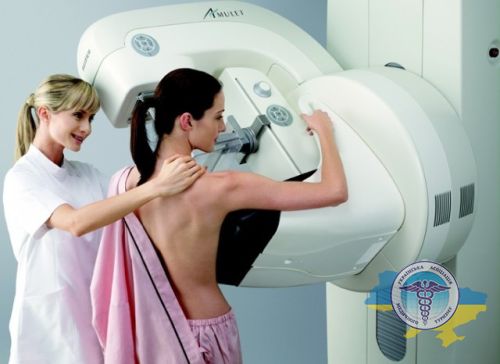Treatment of breast cancer in clinics of Germany

Breast cancer (mammocarcinoma) ranks first among cancer diseases in women. Unfortunately, this disease can affect any representative of the fair sex, regardless of age. The development of breast cancer is influenced by many factors - stress, trauma, hormonal imbalances, environment.
Fortunately, modern medicine has made great strides in diagnosing and treating this disease. The treatment methods used in Germany are especially effective. The country's clinics are in demand due to advanced equipment and highly qualified personnel.
Breast cancer treatment in Germany is carried out comprehensively - the decision on choosing one or another method is made by a council of doctors, among whom surgeons, chemotherapists and radiologists are necessarily represented. In terms of the number of patients treated, German oncology centers occupy leading positions in the world. This can be achieved thanks to the highest qualifications of personnel, the use of innovative technologies and an integrated approach.

Want to know how much the treatment costs?
Answer a few questions and get preliminary information about the cost of diagnosis and treatment!
Advantages of breast cancer treatment in German clinics
- Modern medical equipment. German clinics are equipped with the latest diagnostic and therapeutic equipment. For example, the Nordwest Medical Center operates one of the most advanced linear accelerators for precision tumor radiotherapy.
- Organ-preserving operations. Surgeons try to remove only cancerous tissue as gently as possible, conducting intraoperative examination. This makes it possible in most cases to avoid a radical mastectomy.
- Qualification of oncologists. Statistics on medical errors in Germany are among the lowest in Europe. Foreign patients are accepted only by experienced professors and doctors of the highest category, who bear legal responsibility for the quality of medical care.
- High efficiency. According to the German Cancer Society, 81.6% of patients with this diagnosis who underwent therapy in Germany live for at least 5 years or more. This is an average result typical for any stage of cancer, which is much higher than in the CIS countries, where survival rate usually does not exceed 80% even in the initial stages of the disease.
- The latest techniques. In cases where breast resection is necessary, German doctors try to carry out high-tech oncoplastic interventions using their own tissue or implants to restore the natural appearance of the breast.
- Individual approach. When treating breast cancer, clinics in Germany actively use modern targeted drugs, choosing a personalized treatment option based on genetic studies of the patient’s tumor itself.
Diagnostics of breast cancer in German clinics

During the diagnosis of breast cancer in Germany, the entire range of modern technologies is used. This allows you to identify the disease at an early stage and select a personalized treatment program. Typically, local cancer centers practice:
- Visual examination by a mammologist. During the examination, the symmetry, shape of the breast, color and texture of the skin are assessed. Palpation allows you to identify compactions, swelling and nodes. However, in the primary stages of the disease, the tumor may not be palpable.
- Mammography. The main screening method, which is important to carry out from the age of 40 every 1–2 years. Allows you to identify abnormal areas, microcalcifications before they can be palpated. Suspicious results require additional examination.
- Ultrasound examination. Used to detect tumors less than 1 cm. Provides a three-dimensional image and allows you to assess the condition of regional lymph nodes. Ultrasound complements mammography, increasing diagnostic sensitivity.
- Study of tumor markers. An increased level of tumor markers in the blood may indirectly indicate the presence of a malignant tumor. As a rule, it is used as an auxiliary diagnostic method.
- MRI. Allows you to obtain multiplanar images of the breast in high resolution. It is used to clarify the size and location of the tumor, its relationship to surrounding tissues. If MRI is used with additional intravenous contrast, it helps to differentiate between benign and malignant neoplasms.
- Positron emission computed tomography (PET/CT). A high-precision imaging method that combines PET and CT in one machine. Used to identify distant metastases and assess the extent of the pathogenic process.
- Ductal lavage. Allows you to identify precancerous changes and oncology in the early stages through cytological examination of mammary duct epithelial cells.
- Biopsy. It is a mandatory step before prescribing treatment, which allows us to establish the final diagnosis, morphological type of tumor, and receptor status. The resulting tissue is sent for histological and immunohistochemical examination.
Methods of treatment of breast cancer in Germany

When treating breast cancer in Germany, it is mandatory to adhere to advanced international standards. The treatment plan for each patient is developed at an oncology council, which includes the best specialists.
Treatment is always selected individually, taking into account the characteristics and stage of the tumor, and the patient’s preferences. The main goal is to effectively defeat the disease while minimizing side effects and maintaining a high quality of life.
Surgical intervention
Surgery is the main treatment for breast cancer. Thanks to gentle organ-preserving operations developed by German surgeons, it is possible to preserve the mammary gland in more than 70% of cases.
Lumpectomy
Thanks to the highly qualified German surgeons and the use of modern technologies, for example, intraoperative biopsy, in the early stages of the disease, in the vast majority of cases it is possible to save the patient’s breast.
In a lumpectomy, only the tumor is removed, along with a small margin of healthy tissue around it. Plastic surgery can be performed at the same time to restore the natural shape.
This organ-preserving approach allows you to avoid psychological trauma and maintain quality of life. However, due to the risk of recurrence, lumpectomy is most often combined with radiation therapy. Only in the very initial stages is it possible to perform an isolated lumpectomy.
Unlike Germany, in the CIS countries such sparing operations for breast cancer are performed much less frequently. German surgeons strive to preserve the organ even in difficult cases, using all the possibilities of modern medicine.
Radical mastectomy
The procedure involves total resection of the breast along with the underlying muscles and lymph nodes. Radical mastectomy is prescribed for advanced stages of the disease, when it is impossible to save the organ. Before surgery, a biopsy is required to confirm the diagnosis.
Although this operation is traumatic, it allows you to eliminate the tumor as much as possible and prevent relapses. At the same time, German surgeons are striving to make radical mastectomy less disabling. For this purpose, methods of one-stage breast reconstruction using implants have been developed.
Removal of sentinel lymph nodes
One of the main reasons for relapse in breast cancer is the spread of cancer cells through the lymph nodes. Previously, in order to prevent such a scenario, complete removal of all regional lymph nodes was carried out.
However, such radical lymphadenectomy has significant disadvantages. For example, this can cause impaired lymphatic drainage and the development of lymphostasis of the limb. Also, the procedure does not guarantee the elimination of metastases in distant lymph nodes.
Today in Germany a more gentle approach is used - sentinel lymph node biopsy. These are the primary collectors where lymph flows from the tumor. In the absence of metastases, regional lymph nodes are preserved. This technique allows, in most cases, to avoid complications of extensive lymphadenectomy.
Conservative therapy
In addition to surgical treatment, conservative methods play an important role in the complex treatment of breast cancer. They make it possible to neutralize cancer cells not affected by the operation, reducing the likelihood of relapse and distant metastasis.
The choice of the optimal conservative treatment regimen is based on modern clinical recommendations and taking into account the molecular genetic characteristics of the tumor.
Chemotherapy
It is used both before surgery to reduce tumor size, and after surgery to suppress residual cancer cells. German clinics use highly effective regimens based on taxanes, anthracyclines, and targeted drugs.
Genetic testing of the tumor is used to personalize therapy. Chemotherapy can significantly reduce the likelihood of relapse and improve the prognosis for breast cancer.
Hormonotherapy
Up to 70% of breast tumors are hormone-dependent, that is, they contain estrogen and progesterone receptors. Hormone therapy uses this property to suppress the growth of such tumors.
In Germany, three main groups of hormonal drugs are used:
- Antiestrogens (tamoxifen) that block cancer cell receptors.
- Aromatase inhibitors (letrozole, anastrozole), which suppress estrogen synthesis.
- Androgens (halotestin), which reduce estrogen levels.
Before prescribing therapy, the expression of hormonal receptors must be examined using immunohistochemistry. This allows you to select the most effective drug for each patient.
Hormonotherapy significantly slows the progression of hormone-dependent cancer and improves prognosis. It can be used both as an independent treatment and in combination with other methods.
Targeted therapy
Currently, targeted therapy is actively used in cancer centers in Germany - an innovative approach in which drugs selectively act on cancer cells.
These drugs can significantly improve the effectiveness of treatment, especially in the presence of specific mutations. For example, targeted therapy gives good results in HER2-positive breast cancer.
With this diagnosis, German doctors prescribe trastuzumab, a monoclonal antibody of the Herceptin brand. It is effective both in monotherapy and in combination with chemotherapy. Herceptin is well tolerated, and side effects are observed in less than 5% of patients.
Radiation therapy
Radiation therapy is a technique of local exposure to affected areas using ionizing radiation. The use of high-precision equipment minimizes the impact on healthy tissue. In Germany, radiotherapy is usually started 30-40 days after surgery if there are no complications.
Advanced radiotherapy methods (IMRT, VMAT) are available in German clinics to reduce the load on healthy tissue and reduce side effects. The Intrabeam device and brachytherapy are also used to target the tumor locally with minimal damage to surrounding tissue.
Immunotherapy
Normally, T lymphocytes recognize and destroy cancer cells. However, oncology can “deceive” the immune system by activating inhibitory mechanisms (checkpoints) on lymphocytes.
Checkpoint inhibitors (immunotherapy drugs) help block these mechanisms, unleashing T cell activity against the tumor. This is a relatively new direction in oncology, which has been actively developing in recent years.
In Germany, immunotherapy has already been introduced into clinical practice for a number of cancer diseases. German oncologists have access to modern immunotherapy drugs, and their experience in using them is constantly growing.
Minimally invasive techniques
- Stereotactic radiosurgery. Impact on the tumor and metastases with a concentrated beam of radiation. It is performed using special robotic systems, which increases accuracy and efficiency. The procedure is painless and has virtually no complications.
- Cryomammotomy. Local destruction of the tumor using extremely low temperatures. Under local anesthesia, a small skin incision (up to 1 cm) is made, through which a special cryoprobe is inserted into the tumor, cooled to a temperature of -180-160°C. The probe cools the tissue around it, creating an ice ball with a diameter of up to 4-5 cm. When thawing, damaged cells undergo necrosis and die. The effectiveness of the method is comparable to surgical excision. At the same time, cryotherapy is much less invasive and leaves a good cosmetic result.
- Radiofrequency ablation (RFA). Allows you to destroy malignant tumors using high-frequency radio waves in the range of 375-500 kHz. A probe is inserted through a thin needle, emitting radio waves, which leads to local heating of tissue to 45-60°C. At this temperature, coagulation necrosis and death of cancer cells occurs.
- High intensity focused ultrasound (HIFU). It is based on the creation of ultrasonic waves that are concentrated at the site of the tumor. When focusing, rapid local heating of tissues occurs to 56-85°C, which leads to their coagulation necrosis.
- Brachytherapy. Placing radioactive sources directly into or near tumor tissue. The most commonly used implants are I-125 or Sr-90. Radiation acts locally on cancer cells, destroying them from the inside and minimizing the radiation load on surrounding healthy tissue.
Prognosis for breast cancer treatment in Germany
With timely diagnosis of the disease in the initial stages, the prognosis is very favorable - 5-year survival is achieved in approximately 95% of patients. However, many of them come to the clinic with advanced forms or relapses after unsuccessful therapy in their country of residence.
In such situations, the chances of a complete cure are reduced, and it is more about slowing down the progression of the disease. However, the arsenal of German medicine makes it possible to achieve stabilization even in advanced cases, alleviate symptoms, increase the quality of life of the patient and its duration.
The effectiveness of breast cancer treatment in Germany exceeds not only the CIS countries, but also the average European level. Therefore, by entrusting your health to German oncologists, you can significantly increase the chances of a favorable outcome, regardless of the degree of advanced disease.
Cost of breast cancer treatment in Germany
Despite the impressive price of breast cancer treatment in Germany, visiting the country’s cancer centers is absolutely justified due to the highest quality of medical services and maximum efficiency.
The final cost depends on the stage and form of oncology, the volume of treatment required, the level of the clinic and the qualifications of doctors. To calculate an accurate estimate, it is necessary to conduct an examination and draw up a rough treatment plan.
Approximate prices for individual procedures are presented in the table below:
| Service | Cost, € |
|---|---|
| Initial consultation with an oncologist | from 200 |
| Diagnostics (tests, mammography, ultrasound, etc.) | from 1000 |
| Organ-saving surgery | from 5000 |
| Mastectomy | from 8000 |
| Breast reconstruction | from 10000 |
| Radiation therapy | from 5000 |
| Chemotherapy | from 2000 |
| Immunotherapy for 1 course | from 3000 |



